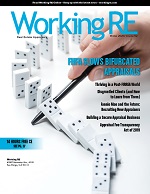 |
“One of the best courses that I have had in 17 years!” -Amy H
>> OREP E&O |
OREP/WRE Coronavirus Appraiser Blog
Coronavirus Appraiser Survey
Upgrade Your Appraisal Skills:
Six Part Coursework from OREP Education
$59 (Free to OREP Members)
When Loans Go Bad – Preparing for the Next Wave
By Rachel Massey
Most of my 30-year career has been as a fee appraiser, but in the crash of 2008 and for quite a while after, I worked as a reviewer in “forensics,” deep-diving into different issues related to when loans went bad. Here’s some of what I learned and how it can be applied to what may be coming.
When a loan went bad the appraisal was not typically the cause, but it could be the focus of the powers that be anyway, particularly during the foreclosure crisis. Investors took a hard look at the appraisal reports and pushed back on the lenders who sold the loan, for anything that they found wrong with the appraisal report. While the appraisal did not cause the default, there were often some loose strings, easy to tug on, that would make the appraiser an easy target. Repurchase demands tended to focus on the “unacceptable appraisal practices” outlined in Fannie Mae’s Selling Guide.
I have written a couple articles about these if interested (see below), but some of the most common issues that were pushed back on are as follows:
1) Calling the market stable or increasing when it was clearly declining at the time. This could be supported by the complainant providing comparable sales that were close to the effective date of the report that were lower than older sales that were included in the report.
2) Not adequately addressing condition of the subject or comparable sales, such as using houses that were materially superior to the subject property without acknowledgement and adjustment. Often the comparable property had significant remodeling, while the subject property was a throwback to the 1970s with no updating, yet quality and condition were referenced as the same.
3) Using sales in areas with higher prices while more proximate and similar properties were available. Map search functions in most MLS can easily show price differences between areas, and the market data gathered by the GSEs related to different areas is robust, and an easy push-back.
4) Failing to address factors that negatively impacted the subject property, such as proximity to highways, toxic waste dumps, etc. Many appraisal reports simply didn’t acknowledge when a property was adjacent to an externality.
Any (and all) of the unacceptable appraisal practices were fair game to elicit a buyback. The selling lender either had to defend the appraisal report, if it were possible, or admit the complaint was correct and end up repurchasing the loan. If the appraisal was found to have several “unacceptable appraisal practices” cited, and the lender could defend some or most of them, they could still be subject to a repurchase if something significant could not be defended.
Times Are Changing
The repurchases were very costly to the party who had to absorb the loss. Repurchase demands hit big and small lenders alike, as well as Mortgage Insurance companies and servicers of loans. Fortunately, they have largely become a thing of the past, in particular with Collateral Underwriter and Day One Certainty providing assurance on the appraisal for that the loan.
That said, even these programs have claw-back language related to description of the property and the accuracy and completeness of all data on the appraisal that pertains to the property, other than the value. This includes the subject’s condition and quality ratings. So even with the advent of Day One Certainty, lenders still have risk involved if there are incorrect statements within the appraisal report. If the lender has risk, so too does the appraiser.
Due to the extraordinary time we are in, with Covid-19 and significant job losses, or even the simple disruption of our daily lives, lending is changing and adapting, as it should. We are moving toward more desktop work or exterior only observations, relying on homeowners, agents and others for information related to their properties. This is reasonable given the circumstances, however, we appraisers still have to do our due diligence to try and obtain sufficient information to adequately and appropriately address our subject property and the market in which it competes.
Preparing for Defaults
Given past repurchase demands, and the likelihood that there will be foreclosures due to job losses, it only makes sense to revisit some of the issues of the past and help protect ourselves in the future. What does this mean to us in the field?
It means being very careful about addressing the market. It is only the beginning of the crisis and none of us can claim to know what the market is going to go. We need to pay close attention to what is happening in our markets with listings, contracts and closings, and interview market participants as to what they are seeing as well. We have to do this with each appraisal we have, and each report we communicate. We have to continue to revisit the unacceptable appraisal practices within the selling guide to make sure we do not knowingly violate any of the practices, and describe the subject and comparable sales to the best of our ability given the information we have.
I recommend a formatted questionnaire for homeowners on refinances which they electronically complete that we can include in our workfile, if not the report itself. We need to examine GIS maps, Google Earth and other sources to make sure we don’t miss something that would have been glaringly obvious if we had been at the property. We need to do our due diligence on a ramped-up scale in my opinion.
If you are able and comfortable completing interior observations, you will still need to focus effort on market analysis. Some markets may be humming along nicely, while others could be compromised and declining. It is imperative that we continue to research our markets with whatever tools we can cobble together.
Now is not the time to relax our guard if we are not able to see the interior of a property. We still are responsible for our analysis and conclusions, and we still have to do the hard work, which is much harder than it was a few months ago, before our world changed. Stay safe everyone!
Additional stories by author Rachel Massey:
Repurchase Demands – Part 1
Repurchase Demands – Part 2
>> Six Part Appraiser Coursework from OREP Education
Register: $59 (Free to OREP Members)
Don’t Miss Tomorrow’s Course (Part 3 of 6):
Why the Cost Approach is Valuable
(and Helps You Earn Higher Fees)
“This was my first time to listen to one of Richard Hagar’s courses and I wish I had done so much sooner! Very valuable info and easy to understand. Thank you very much for providing this free tool as part of my OREP membership!” -RM
>> Join the Discussion at OREP/Working RE’s Coronavirus (COVID-19) Discussion and Resource Page/a> where you can share your thoughts, experiences, advice and challenges with fellow appraisers.
>> Take OREP/Working RE’s Coronavirus: State of the Appraisal Industry survey here.
About the Author
Rachel Massey, SRA, AI-RRS, is an AQB Certified USPAP instructor and has been appraising full-time since 1989. She is a Certified Residential Appraiser in Michigan, specializing in relocation work for various clients, as well as lake properties and other residential properties. Please visit https://annarborappraisals.com for more information.
CE Online – 7 Hours (AQB Approved)
Identifying and Correcting Persistent Appraisal Failures
Richard Hagar, SRA, is an educator, author and owner of a busy appraisal office in the state of Washington. Hagar now offers his legendary adjustments course for CE credit in over 40 states through OREPEducation.org. The new 7-hour online CE course Identifying and Correcting Persistent Appraisal Failures shows appraisers how to avoid CU’s red flags, minimize callbacks, save time, and earn more! Learn how to improve the quality of your reports and build defensible reports! OREP insureds save on this approved coursework. Sign up today at www.OREPEducation.org.
Sign Up Now! $119 (7 Hrs)
OREP Insured’s Price: $99
>Opt-In to Working RE Newsletters
>Shop Appraiser Insurance
>Shop Real Estate Agent
Insurance
Send your story submission/idea to the Editor:
isaac@orep.org





by Thomas Tipton
Way back in the good ole days of appraising, a primary lender was targeted for a repurchase request on an old, historic house that I had appraised in 1996 for a re-finance loan. In less than 2 years the lender was notified of the repurchase request due to the borrower’s default on the mortgage. The lender did not want to repurchase the loan for the obvious reason of cost. Of course the ONLY good defense the ‘original’ lender could raise was to have me, the appraiser, refute the accusations being raised that it was a ‘bad’ appraisal, which I was able to do. The major support in my appraisal were the interior photos of all the remodeling, and updating done to that old, historic house. This was in the days prior to the lender requirements of interior photos of all rooms, and support for recent updates. The primary lender was supportive of my appraisal because it was in their best interest, and of course it was a good, thorough appraisal report. Nowadays, we must do much, much more to support our appraisals. The author of this article is raising awareness that appraisers must document much, much more than just interior photos in our appraisal reports. There should be no question in anyone’s thinking today that we are on the cusp of a tsunami wave of mortgage defaults. It is coming, and as an appraiser who does forensic appraisal reviews it is without question there are a vast number of appraisals written in the past few years that are woefully insufficient to withstand even a modest review.
-by Jerry Allegro
It’s pretty funny that you never run articles from real in the files appraisers only these Ai clones. When was the last time you talked about how to avoid dishonest and corrupt AMCS WHERe IS A LIST FOR US TO AVOID? When do appraisers get any respect? It’s ok to be exposed to 19. But not to have our fees guaranteed against crooked amcs. Not to be protected on site if you get injured and be told from Allstate that you are no better than the illegals on the lawn crew. Just eat that 20k in medical bills. Or Adam bell at consolidated lenders able to steal $15000 in FHA funds and have his actions sanctioned by the corrupt morons at the state of Texas. Ask Mark Lee what a corrupt and inept idiot he he is. Duh we made some mistakes!! Or maybe Appraisal Nation with their predetermined outcome and appraiser coercion. When you don’t give in they try to destroy you at the state with a frivolous complaint and you get to lose $12000 in legal fees to be exonerated after being taped by the state. Such a lovely profession. Maybe you might want to do something real other than advertise and collect revenue with all this phony nonsense just saying?
-